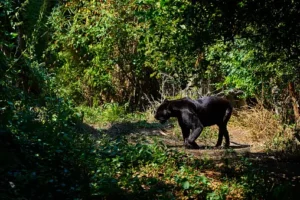Introduction Of Black Panther!
The black panther, scientifically known as the melanistic variant of the leopard (Panthera Pardus) or jaguar (Panthera once), is a captivating and enigmatic big cat species. This striking creature is characterized by its entirely black coat, which is a result of a genetic mutation causing an excess of melanin pigment in its skin and fur.

With a sleek and powerful physique, the black panther exhibits remarkable adaptations for hunting and survival. Its stealthy nature and exceptional night vision make it a proficient nocturnal predator, capable of stalking its prey with precision. The black panther’s adaptability to various habitats, including dense forests, savannas, and swamps, has contributed to its wide distribution across regions of Africa, Asia, and the Americas.
Though the term “black panther” often conjures images of a distinct species, it is crucial to note that these animals are melanistic variants of their respective species—leopard or jaguar. Despite their dark coloration, their striking features and behaviors are a testament to their extraordinary abilities as apex predators within their ecosystems.
The black panther’s aura of mystery, coupled with its role in various cultures and mythologies, continues to captivate the human imagination. As a symbol of strength, stealth, and adaptability, the black panther stands as a testament to the incredible diversity and resilience of the natural world.
Melanistic Marvel:

The captivating world of black panthers unveils a remarkable natural phenomenon known as melanism. Melanistic marvels are not a distinct species but rather a genetic variation of leopards or jaguars, resulting in their striking black coats. This fascinating adaptation occurs due to an excess of melanin, the pigment responsible for coloration in their skin and fur.
Black panthers’ alluring appearance is matched by their exceptional hunting prowess. Their dark coats provide camouflage in dense habitats, enabling stealthy nocturnal activities. These enigmatic creatures thrive in a variety of ecosystems, from dense forests to arid savannas. Melanism, while enhancing their beauty, also holds insight into genetic diversity and evolutionary strategies.
Beyond their physical prowess, black panthers have found a place in human culture and mythology, symbolizing power and mystery. As our understanding of these melanistic marvels deepens, it becomes evident that they represent both the extraordinary intricacies of genetics and the timeless allure of the natural world.
Adaptations for the Night :

Black panthers exhibit a range of remarkable adaptations that enable them to excel as nocturnal predators. Their keen senses and physical attributes are finely tuned for navigating the darkness. Enhanced night vision, owing to a high concentration of rod cells in their retinas, allows them to detect even the slightest movements in low light conditions. Their pupils dilate widely in the dark, capturing as much available light as possible.
Exceptional stealth is another crucial adaptation. A black panther’s dark coat provides exceptional camouflage in dim environments, helping it to blend seamlessly into the shadows. Their lithe bodies, padded paws, and retractable claws facilitate silent movement, ensuring they can approach prey without detection. Acute hearing further aids their hunting prowess, allowing them to discern rustling sounds and locate potential prey.
Black panthers are opportunistic hunters with powerful jaws and sharp teeth. Their strong jaw muscles and sharp canines enable them to deliver swift and lethal bites to their prey’s neck or throat. This combination of heightened senses, stealthy movement, and powerful weaponry makes the black panther a truly adept and fearsome predator in the cover of night.
10 Astonishing Facts About Lion
Leopard’s Dark Side:
The enigmatic world of leopards is adorned with a mysterious and captivating aspect—the melanistic variant, often referred to as the black panther. These sleek felines, characterized by their strikingly dark coats, are not a separate species but rather a manifestation of a genetic quirk. The presence of excess melanin causes their characteristic black coloration, setting them apart from their spotted counterparts.
Melanistic leopards thrive in a diversity of habitats, from dense jungles to arid grasslands, displaying remarkable adaptability. Their stealth and agility, coupled with the advantage of enhanced camouflage in dim light, make them formidable predators. Black panthers’ elusive nature adds an air of intrigue to their presence in various cultures and mythologies.
Despite their allure, melanistic leopards face challenges due to habitat loss and human conflict. Recognizing their ecological significance and unique beauty, conservation efforts are crucial to ensure the survival of these shadowy marvels and the preservation of the intricate balance they contribute to within their ecosystems.
Jaguar in Shadows:

The enigmatic presence of black panthers, also known as melanistic jaguars, adds an aura of mystery to the landscapes of the Americas. These dark-coated variants of the jaguar species, Panthera onca, dwell predominantly in the dense rainforests of Central and South America. Their sleek obsidian coats conceal them within the shadows of the jungle, allowing them to seamlessly blend into the darkness.
The melanistic coloration is attributed to an excess of melanin, which gives their fur its deep black hue. Despite their inky appearance, their spot patterns are still faintly visible when illuminated by light. Renowned for their strength, agility, and ability to swim, these apex predators exert their dominance over their territories. Often associated with ancient indigenous beliefs and revered as symbols of power and stealth, the black jaguars continue to capture the fascination of cultures and conservationists alike. Yet, their elusiveness and the challenges of studying them in their natural habitat underscore the need for concerted efforts to understand and protect these shadowy inhabitants of the Americas.
Camouflaged Predators:
Black panthers, the melanistic variants of leopards and jaguars, showcase remarkable camouflage that aids their survival in diverse habitats. Their distinctive black coats blend seamlessly with the shadows of the night, affording them an advantage in stealthy pursuits. In dense forests, the dark coloration makes them nearly invisible amidst the foliage, facilitating undetected movement as they stalk prey.
This exceptional adaptation enables black panthers to excel as ambush predators. Their ability to remain concealed until the opportune moment ensures a higher success rate in hunting. Whether amidst the dense undergrowth of tropical forests or the muted hues of rocky landscapes, black panthers exploit their cryptic coloration to outwit their prey.
Moreover, their camouflage also serves to evade potential threats. In the wild, where survival hinges on the ability to avoid both predators and competition, the black panther’s mastery of disguise plays a pivotal role. As an embodiment of nature’s ingenuity, the camouflaged prowess of black panthers stands as a testament to the intricate balance between adaptation and survival in the animal kingdom.
Genetic Enigma:
The “Genetic Enigma” of the black panther lies in its unique coat coloration, attributed to a genetic mutation leading to excessive melanin production. Melanin, responsible for skin and hair pigmentation, accumulates excessively in these big cats, resulting in their striking black hue. This genetic variation occurs in both leopards and jaguars, occasionally producing the melanistic form. This adaptation raises intriguing questions about the interplay between genetic inheritance, environmental factors, and the advantageous role of the black coat in survival.
The genetic enigma extends to the inheritance patterns of this trait, with melanism being a recessive characteristic. This means that not all individuals of these species will exhibit the black coat, even if carrying the gene. The study of this genetic variation provides insights into how certain traits persist in populations and underscores the fascinating complexity of nature’s genetic landscape.
30 Amazing Facts About Deer And Types
Stealth and Hunting:

Stealth and hunting are integral components of the black panther’s survival strategy. Equipped with exceptional night vision and heightened senses, these elusive creatures navigate darkness with unparalleled finesse. Their dark, melanistic coats provide effective camouflage in dimly lit environments, enabling them to move undetected.
Black panthers are skilled stalkers, meticulously observing their prey before launching precise and swift attacks. Their powerful musculature and sharp claws allow them to swiftly pounce, overpowering animals with a calculated burst of speed. Stealthy movement and silent footfalls minimize the chances of alerting potential prey.
By embracing their inherent stealth and hunting prowess, black panthers secure their place as apex predators. This mastery of nocturnal tactics ensures their successful foraging and sustains their populations across diverse ecosystems.
Cultural Icons:
The enigmatic allure of the black panther transcends its natural habitat, influencing diverse cultures and symbolizing a range of qualities. Revered for its strength and elegance, the black panther often appears in indigenous folklore as a symbol of power and prowess. In African traditions, it embodies traits of leadership and resilience, while in some Asian cultures, it’s linked to mysticism and protection.
The black panther’s symbolic significance extends to modern times, gracing literature, art, and film. Marvel Comics’ “Black Panther” character, for instance, champions innovation and justice. This apex predator’s shadowy demeanor and adaptability have etched it into the tapestry of human imagination, becoming a cultural emblem of strength, mystery, and the wild spirit.
Conservation Concerns:

Conservation concerns surrounding black panthers, which are melanistic variants of leopards and jaguars, revolve around habitat loss, poaching, and genetic diversity. Rapid urbanization and habitat fragmentation threaten their natural homes, pushing them into smaller and more isolated areas. This diminishes their access to prey and increases human-wildlife conflicts. Poaching for their striking pelts and body parts exacerbates their vulnerability.
Furthermore, the small populations of black panthers may face challenges related to genetic diversity due to their limited gene pool. Inbreeding depression could lead to weaker individuals and reduced survival rates. Conservation efforts must prioritize the preservation of suitable habitats, anti-poaching measures, and genetic management to ensure the survival of these captivating creatures. Collaborative strategies between governments, conservation organizations, and local communities are essential to safeguarding the future of black panthers and their vital role in maintaining ecological balance.
Unveiling Panthera:
Panthera, a genus within the Felidae family, comprises some of the world’s most iconic big cat species. This distinguished group includes the majestic lion (Panthera Leo), the elusive leopard (Panthera Pardus), the powerful tiger (Panthera Tigris), the agile jaguar (Panthera once), and their melanistic counterparts, often referred to as black panthers. United by shared characteristics such as retractable claws, keen senses, and a carnivorous diet, Panthera species have adapted to diverse habitats, from the grasslands of Africa to the rainforests of Asia and the jungles of the Americas.
Renowned for their roles in ecosystems and cultural narratives, these apex predators exemplify the beauty and resilience of Earth’s biodiversity. However, many Panthera species face threats like habitat loss and poaching, necessitating urgent conservation efforts to safeguard their survival and the ecological balance they maintain. “Unveiling Panthera” offers a glimpse into these magnificent creatures, fostering appreciation for their significance and promoting the imperative of protecting them for generations to come.
Diet of Black Panther:
The diet of a black panther, which is essentially a melanistic variant of a leopard or a jaguar, closely resembles that of its non-melanistic counterparts. These carnivorous predators are opportunistic hunters with a versatile palate. Their diet primarily consists of a variety of prey species, chosen based on availability and the panther’s habitat.
Leopards, including the black panther variant, are known for their adaptability and can thrive in a range of environments, from dense forests to grasslands. They are skilled ambush predators, often targeting animals smaller than themselves, such as deer, wild boar, and smaller mammals like monkeys or rodents. Leopards are also known to opportunistically scavenge or steal kills from other predators.
Similarly, black jaguars, found predominantly in the Americas, exhibit a diverse diet that includes deer, peccaries, tapirs, and smaller mammals. These apex predators are equally adept swimmers and climbers, allowing them to access a broader range of prey.
Both black panthers, whether leopard or jaguar, rely on their remarkable stealth, keen senses, and powerful physiques to capture and overpower their prey. Their dark coats, although striking, offer an advantage in the cover of night or dense vegetation, enhancing their ability to surprise and successfully hunt. The diet of a black panther ultimately reflects the intricacies of its ecosystem and its vital role in maintaining the balance of nature as a top carnivore.
Diseases of Black Panther:
Black panthers, the melanistic variants of leopards and jaguars, face a range of health challenges that can impact their populations and ecosystems. While these creatures exhibit remarkable adaptations, their susceptibility to various diseases underscores the delicate balance of nature and the need for robust conservation efforts.
Like their non-melanistic counterparts, black panthers are vulnerable to a variety of infectious diseases. Feline immunodeficiency virus (FIV) and feline leukemia virus (FeLV) are of particular concern, as they can weaken the immune system and compromise the panther’s ability to fend off other infections. Additionally, parasites such as ticks, fleas, and internal worms can afflict these cats, affecting their overall health and survival.
Habitat loss and fragmentation further exacerbate disease risks for black panthers. As their territories shrink due to human encroachment, panthers are forced into closer proximity, facilitating disease transmission. Furthermore, the intrusion of domestic animals into their habitats increases the potential for disease spillover from domestic cats to wild populations.
One significant threat is a disease known as feline panleukopenia, or “cat distemper.” This highly contagious viral infection can cause severe gastrointestinal and immune system issues, often leading to death in affected individuals. The spread of this disease among black panther populations could have devastating consequences, particularly due to their small numbers and limited genetic diversity.
Conservation strategies must address disease management alongside other pressing issues. Regular health monitoring, vaccination programs, and research into disease transmission dynamics are essential components of safeguarding black panther populations. Habitat preservation and minimizing human interference are also critical to reducing stress and the associated susceptibility to diseases.
In conclusion, the diseases that afflict black panthers highlight the complex challenges these magnificent creatures face in their fight for survival. As stewards of our planet’s biodiversity, it’s imperative to recognize the interconnectedness of disease, habitat, and conservation efforts. By prioritizing the health and well-being of black panthers, we contribute to the preservation of an integral component of our natural world.
FAQ’s:
What is a black panther?
A black panther is not a distinct species but a term used to describe melanistic variants of leopards (Panthera Pardus) or jaguars (Panthera once). Melanism is a genetic mutation that results in an excess of dark pigment (melanin) in their fur, causing them to appear predominantly black.
Where can black panthers be found?
Black panthers can be found in various regions, including Africa, Asia, and the Americas. Black leopards are commonly found in dense forests and grasslands of sub-Saharan Africa, while black jaguars inhabit rainforests and swamps in Central and South America.
How does the black panther’s coloration help it survive?
The black panther’s dark coloration provides excellent camouflage in their natural habitats, making them effective predators. This coloration helps them blend into shadows and foliage, enhancing their stealth during nighttime hunting.
Are black panthers more aggressive than their non-melanistic counterparts?
The behavior and aggressiveness of black panthers are not significantly different from other leopards or jaguars. Their behavior is influenced by factors like age, sex, and territory rather than their coloration.
Do black panthers have any cultural significance?
Yes, black panthers hold cultural significance in various societies. They often symbolize strength, mystery, and adaptability. In some cultures, they are considered spiritual or mythological creatures, while in others, they are used as symbols of leadership or protection. Additionally, black panthers have made appearances in literature, art, and popular culture, contributing to their iconic status.


